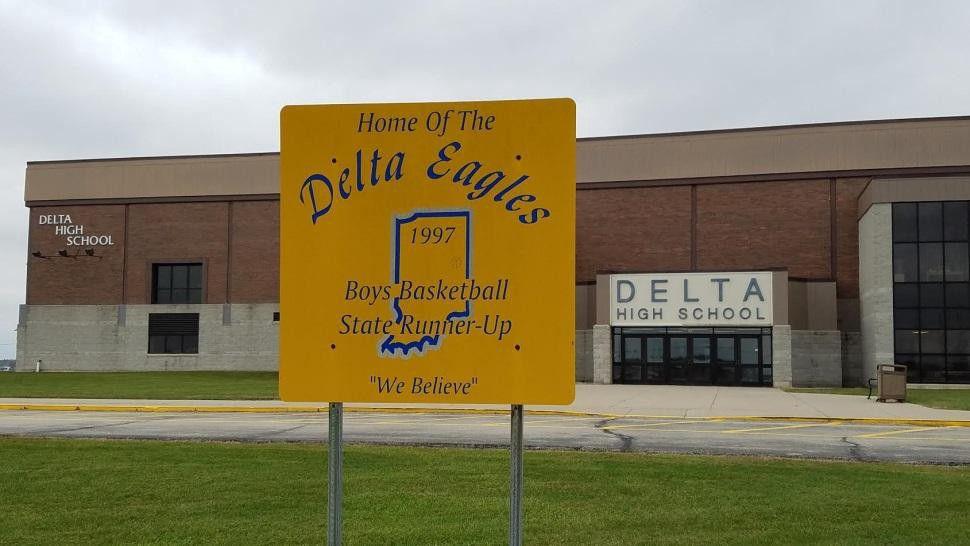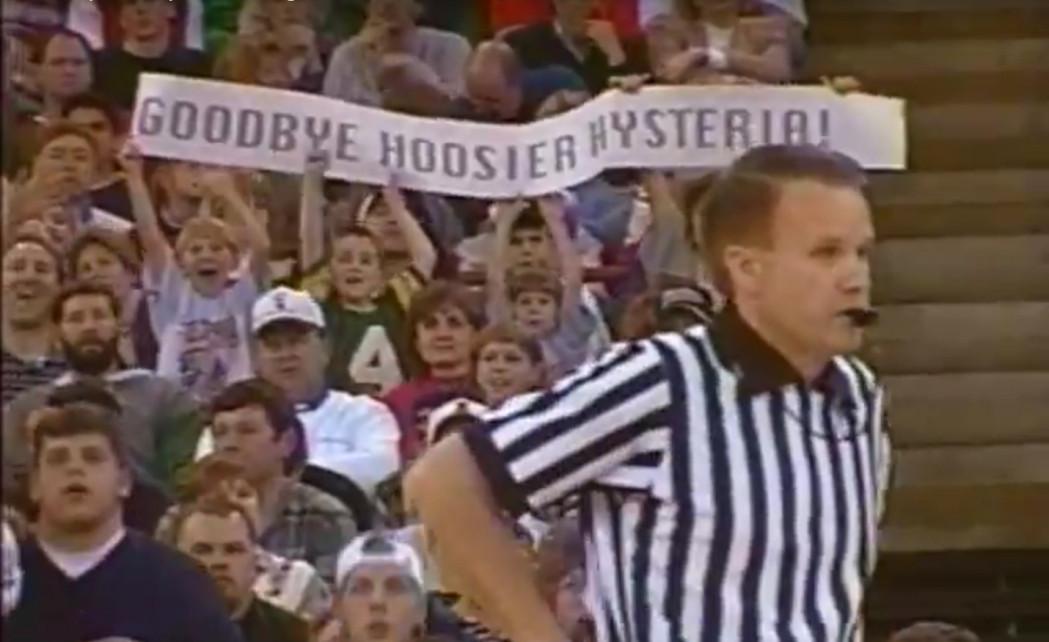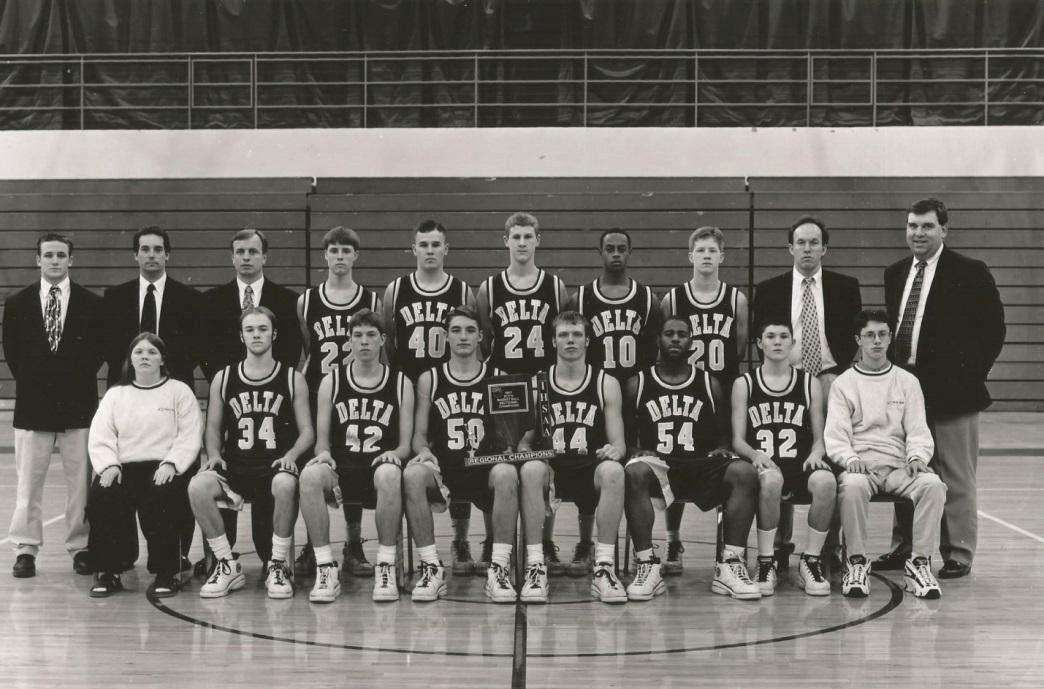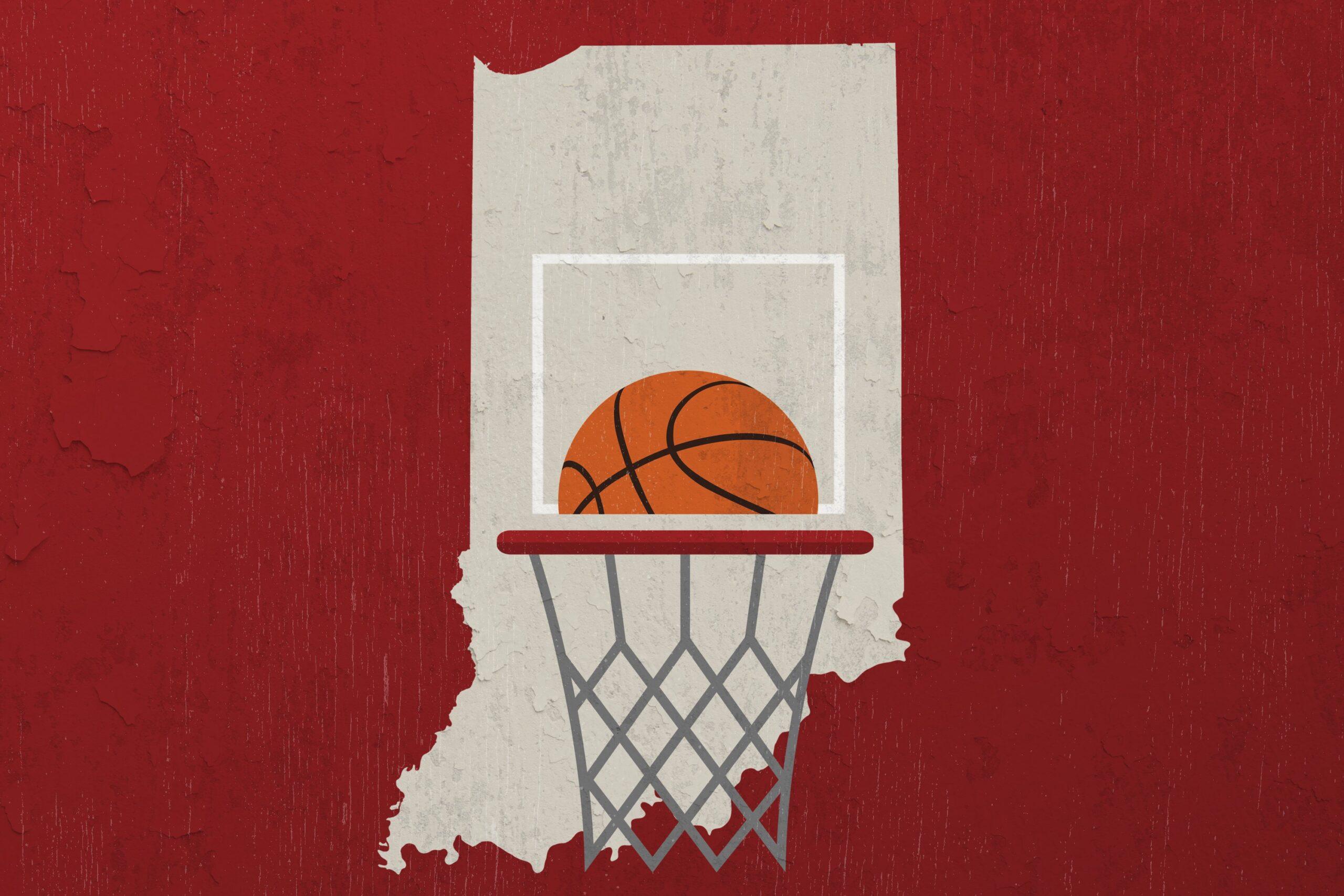The Crossroads of Hoosier Hysteria
Examining Indiana’s relationship with the sport it loves—20 years after its high school basketball went to a class system"Basketball really had its origin in Indiana, which remains the center of the sport." — James Naismith
It was a few months before my 10th birthday in 1997 when my dad and I went to the Indiana high school state basketball finals at the RCA Dome in downtown Indianapolis. I was too young to know much of anything at the time, but this I knew for certain: I loved basketball. I mean, I looooooved it, to the point that I judged my third-grade classmates based solely on their basketball ability. It consumed my every thought.
I guess I never really had a choice. My dad went to high school in the 1970s in Logansport — a small Rust Belt city that’s 90 minutes north of Indianapolis and is every bit of what you’d picture a small Rust Belt city to be like. It’s easy to be drawn to the chapters in Indiana basketball lore that tell stories of tiny farm towns or mention the great players who came from cities such as Indianapolis, Fort Wayne, and Gary. But make no mistake: The small manufacturing cities like Logansport, New Castle, Marion, Kokomo, Anderson, Richmond, and Muncie are where Hoosier Hysteria reached its apex, especially during the ’60s, ’70s, and ’80s. By 1985, seven of the eight schools in my dad’s high school conference (North Central Conference) played in gyms that held more than 6,500 people, while the smallest gym in the NCC had a capacity of nearly 6,000.
Like so many Hoosier fathers before him, my dad wasted no time sinking his basketball claws into his son. My first memories are hurling a tiny plastic ball toward a Little Tikes basket in our driveway as my dad shot on a full-sized hoop. If his bedtime stories weren’t about former Kentucky star Kyle Macy scoring 47 points on him in high school, or how all of those mammoth gyms he played in were always packed to the rafters, they were about Pete Maravich or Larry Bird. The doctor who delivered me didn’t hand a son to a father as much as he handed a giant block of marble to a basketball-crazed maniac eager to sculpt.
As I got older, Friday nights in the winter began to follow a familiar script: My dad would come home from work and leave his ’92 Buick Century running in the driveway so that he wouldn’t have to warm it back up later. He’d shove whatever meat and potatoes my mom had made for dinner into his mouth before we’d jump in the car and drive through one snow-covered cornfield after another, the monotony broken only by three-room churches, cemeteries with fewer than 20 headstones, and barns with basketball rims affixed to their sides. We’d arrive at a high school somewhere in central Indiana — usually the one where my dad was the athletic director — and I’d watch perfectly ordinary 17-year-old kids transform into superheroes.
After a high school game ended, my dad would get the game ball from the refs so that I could shoot around when all of the fans, players, and coaches had left. Then, with my audience consisting of janitors, I’d recreate the plays I saw that night while dreaming of someday creating highlights of my very own. On the drive home, we’d throw on Bob Lovell’s Indiana high school basketball radio show as background noise, talk about the game we’d just watched, and formulate a plan to persuade my mom to buy us a pizza when we got back.
This was what I knew for as long as I can remember. Basketball wasn’t just a big part of my life — it was essentially the only part, and high school basketball was the epicenter of my childhood world.
And now I was going to my first state finals game, one that represented the end of an era.

"As everyone knows, Indiana is divided into two parts: 1. Basketball. 2. All That Other Stuff." — James Alexander Thom
The 1997 Indiana state championship was, by almost any measure, a bad basketball game. Bloomington North High School, ranked no. 1 in the state and fronted by Kueth Duany (who would go on to captain the 2002–03 national champion Syracuse team), led unranked Delta High School 7–0 at the end of the first quarter and cruised to an easy 75–54 win. It’s only by rewatching the game on YouTube that I can report that Delta’s entire roster wore Chuck Taylors, Bloomington North’s coach kept a pen wedged behind his ear, and Delta’s best player was a kid named Patrick "Petie" Jackson, who had an Anthony Mason haircut and would go on to break Kansas point guard Aaron Miles’s ankles en route to making Ball State’s game-winning layup in the 2001 Maui Invitational. In truth, I remember a single thing about that ’97 title game.
"We believe."
That was Delta’s rallying cry throughout its state tournament run, and one I heard fans yell a few hundred times that day in late March. See, Delta was and still is a rural school, surrounded by cornfields on the outskirts of Muncie, with an enrollment under 1,000. In its 30 years of existence to that point, Delta had never produced a boys’ basketball team that even made the Sweet 16 of the state tournament.
The 1996–97 team lost to Muncie Southside High School by 27 points earlier in the season, suggesting that Delta wasn’t even the best team in its own city. In its second game of the state tournament, it required a made free throw with one second remaining to squeak past Wapahani High School, a team it had previously lost to by 18. That January, Delta head coach Paul Keller benched three of his starters (two of whom had scored more than 1,000 points in their respective careers) because the team was doing so poorly. In February, Delta’s sixth man broke his arm and was forced to play in a soft cast for the remainder of the season. Delta averaged 12.5 turnovers a game, started a center who was 6-foot-1, and had to erase deficits of 16 and 14 points just to get to the state championship.
I’d admittedly be laying the romanticism on a little thick if I likened Delta to the 1954 Milan High state champion team that inspired Hoosiers, even though Delta used the same Hinkle Fieldhouse locker room during its state tournament run that Hickory High used in the movie. Regardless, the point remains: The Delta Eagles had no business playing in the 1997 state championship.
And yet there they were, fueled by thousands of fans from east central Indiana who believed.

As the game wore on and Bloomington North sustained its dominance, Delta’s cheerleaders assumed the role of the orchestra members on the Titanic, continuing to lead the "We believe" chant either out of habit or because they really were crazy enough to believe a miracle was imminent. I was captivated. The game itself no longer mattered. My attention was squarely focused on these lunatics from Muncie who didn’t seem to notice that their team was getting its ass kicked.
I later learned that so much of this passion stemmed from the fact that the ’97 title game was the final one in which Indiana would crown a single high school boys’ basketball state champion. The Indiana High School Athletic Association was set to institute a class system based on enrollment the following season, bringing an end to an 87-year tradition that was, for my money, the best high school athletic tournament in the world. Delta would compete in class 3A (the second-largest class), meaning the chance to beat a school twice its size, in this setting, with the entire state watching would never come again. This game — win or lose — was the culmination of a Cinderella run that would forever be the last of its kind.
The cheers from Delta’s fan base weren’t solely for this one basketball game that was going very, very poorly; they were for the three weeks of magic that led to that point, and the 87 years of underdog stories that came before. They were a declaration that a blowout loss would do nothing to soil a memory that would last a lifetime.

"An Indiana player has the enthusiasm of an evangelist, the discipline of a monk, and the heart of a warrior who never loses the honesty and character of a small boy." — Bob Knight
It’s hard to articulate to people from outside Indiana what Hoosier Hysteria really is. The simple answer is that it’s a term used to describe the love affair people in the state have with basketball. But it’s not enough to understand the what. Far more important is the why.
Basketball took hold in Indiana shortly after its invention at the turn of the 20th century, primarily because of the state’s farming culture. With so many young Hoosier men busy planting crops in the spring, fertilizing them in the summer, and harvesting them in the fall, baseball and football couldn’t catch on in Indiana as they did in states where manufacturing was king: Ohio, Michigan, and Pennsylvania. But basketball checked every box that Hoosiers needed out of a sport. It was played during the winter, the one season in which farmers had a significant amount of free time. It was played indoors, giving thousands of Hoosiers an activity that didn’t involve trekking out into the harsh winter weather. And most importantly, unlike football and baseball, it could be played with just a handful of people, meaning even tiny farm schools could put together a team. Over time, basketball in Indiana developed from a curious oddity to a convenient distraction to a passionate pastime to a full-blown obsession, until it finally became the thing that lies at the heart of Hoosier Hysteria: a point of pride.
There’s no denying that Indiana isn’t the first state that comes to mind when thinking about the best America has to offer. The obesity and pollution statistics are awful, the archaic alcohol laws are worse, and venturing too far from Indianapolis is to discover what true boredom looks like. Indiana was recently named the meth capital of the country, which would probably be the state’s biggest disgrace if not for the KKK’s pervasive presence there in the 1920s. For the most part, we Hoosiers are simple folks who work our asses off, earn what we get, and are among the nicest people you’ll ever meet. But the same could be said about much of the United States’s populace. The list of things that set Indiana apart includes, regrettably, a lot of bullshit.
But the shining beacon of hope at the top of that list is basketball.
And that’s the important distinction: Basketball isn’t just something we love. It’s intertwined with our identity. It’s the ace up our sleeve when anyone tries to put us down. The Indianapolis 500 is great, but it’s really a race that belongs to the world and happens to take place in Indiana. Basketball is our one true export. It’s the thing that Hoosiers can point to and say, "We may not bring much to the table, but we bring this. And goddammit we couldn’t be more proud."
It’s pretentious, I know, but it should also be noted that the basketball itself is different in Indiana. Or at least, that’s what Hoosiers would like to believe. We like to think that ours is a form of basketball in which fundamentals, teamwork, and effort supersede size and athleticism. We like to think our players are perfectly crafted and can’t be found anywhere else in the world. Whether basketball in Indiana really is akin to cigars from Cuba or wine from the south of France is irrelevant. To Hoosiers, there’s basketball, and then there’s Indiana Basketball.
That, I suppose, is why Delta fans chanting "We believe" in 1997 has stuck so vividly in my mind. That entire scene — an undersized and undermanned Cinderella with a community cheering it on — was quintessential Indiana Basketball. If words can’t properly define what Hoosier Hysteria is, those two hours can. Because above all else, Hoosier Hysteria is about celebrating the underdog.
Just think about the Indiana basketball stories you know. Outside of Bob Knight’s three national titles at IU, virtually every notable thing that has happened with a basketball team from the state could be framed as an underdog story. Milan in 1954. Larry Bird and Indiana State in 1979. Purdue’s Final Four run as a no. 6 seed in 1980. Indiana’s run to the national title game as a no. 5 seed in 2002. Christian Watford’s shot to upset top-ranked Kentucky in 2011. Butler’s back-to-back national title game appearances, the first of which included Gordon Hayward’s near-miss that came inches away from going down as the greatest shot in sports history. Notre Dame snapping UCLA’s 88-game winning streak in 1974 and coming a shot away from ending Kentucky’s perfect season in the 2015 Elite Eight. Ball State’s run to the 1990 Sweet 16, where the 12th-seeded Cardinals gave eventual national champion UNLV its only tournament scare in a 69–67 loss. Reggie Miller’s Pacers taking part in the "Hicks vs. Knicks" rivalry from the ’90s, almost derailing Michael Jordan’s Bulls dynasty in the 1998 Eastern Conference finals, and going up against Shaq and Kobe in the 2000 NBA Finals.
Hell, Indiana loves underdogs so much that when our teams aren’t in that role, it’s almost as if we find ways to screw things up. The 1974–75 Hoosiers were undefeated until Scott May’s broken arm preceded an Elite Eight loss to the same Kentucky team that IU had beaten by 24 points earlier that year. The 1990–91, 1992–93, and 2012–13 Hoosiers were arguably the best teams in the country during those respective seasons, yet each also failed to reach the Final Four. Gene Keady had six 25-win seasons in his 25-year coaching tenure at Purdue; he never made a Final Four and only one of those six campaigns resulted in a trip to the Elite Eight. The 2005 Pacers were favorites to win the East and maybe even the NBA Finals before The Malice at the Palace set the franchise back a decade. And Butler hasn’t done much since the college basketball world started treating it as more than a tournament darling. It’s like any time an Indiana team starts shedding its underdog label, the universe steps in to correct its mistake.
Isn’t that a little curious how a state that prides itself on its rich basketball history always seems to be an underdog? If Indiana Basketball really is one of the world’s most prestigious brands, why has it been almost 30 years since the state last produced a basketball juggernaut?


"A Hoosier talks about basketball for an hour after he is dead and has stopped breathing." — Kurt Vonnegut
The 2016–17 Indiana high school boys’ basketball season officially begins this week, marking the start of the 20th season of class basketball in the state. Depending on who you ask, this signifies either the 20th anniversary of the biggest mistake an Indiana governing body has ever made or two decades of pride and joy for small communities that otherwise would’ve lacked the chance to experience a state title. No matter which side a person falls on, all Hoosiers who are old enough to remember the 1990s can agree on one thing: Indiana high school basketball is drastically different than it used to be.
If I were alarmist, this is where I’d make the case that Hoosier Hysteria is dying. And honestly, part of me worries that it is. Anecdotally, attendance for high school games has been steadily declining for decades, and some of the most historic and iconic gyms in the state are on their deathbeds. The reasons are plenty, and people all over the state will gladly say which they believe are most at fault: AAU culture, the internet, the rise of football following the success of the Peyton Manning–era Colts, Title IX, the economy and job market, the emergence of all sorts of entertainment alternatives. But every one of these discussions circles back to the advent of class basketball.
If nothing else, that 1997 state title game was a clear turning point in the Indiana basketball history books. The installation of the class system isn’t directly responsible for everything that followed, of course, but the landscape of basketball in the state has unquestionably changed since. Knight was fired from IU in 2000. Keady retired from Purdue in 2005. On two separate occasions (2005 and 2014), no team from the state participated in the NCAA tournament, an occurrence that hadn’t previously happened since 1972, when the tournament fielded only 25 teams. During the final 19 years of the one-class system, 14 of the 21 Mr. Basketballs (there were two ties) chose in-state schools for college. Only nine of the last 19 Mr. Basketballs stayed in Indiana, and one (Purdue’s Caleb Swanigan) has since 2012. Over the past 19 seasons, the 10 Division I college programs in Indiana have combined for 17 Sweet 16 berths, six Elite Eights, three Final Fours, and zero national titles. (For comparison, over that same span Duke has 15 Sweet 16 berths, seven Elite Eights, five Final Fours, and three national titles.) The Pacers, who were perpetually in NBA championship contention near the turn of the millennium, blew up the foundation of their franchise when Miller retired in 2005. They’ve won 50 games in a season just once since.
Put more succinctly: There are kids all over Indiana who will play in high school games this week having never lived in a world where the Hoosiers were in the Final Four. And there are parents of those kids who have never lived in a world where Purdue or Notre Dame have played in a Final Four.
For anyone brainwashed on the religion that is basketball in Indiana, that’s jarring. For everyone else, it should explain the current psyche of fans across the state pretty well. This is why so many IU and Purdue fans jumped on the Butler bandwagon in 2010 and 2011. There was more at stake than just loyalty to a particular school. Butler represented the Indiana Basketball brand. At a certain point, we’ve grown so desperate to relive the magic of Hoosier Hysteria that we’re willing to embrace anything that slightly resembles it. That explains how the Robbie Hummel–era Boilermakers have given Matt Painter more job security than he probably deserves. It’s also why IU fans stormed the court against Kentucky in 2011, why the loss to Syracuse in the 2013 Sweet 16 felt like the death of a loved one, and why Indiana’s win over third-ranked Kansas in the season opener on November 11 has left Hoosiers fans delirious.
It’s like Tywin Lannister says on Game of Thrones: "Any man who must say ‘I am the king’ is no true king." Hoosiers have been forced to remind the rest of the country who the basketball king is with increasing frequency over the last two decades, to the point that many of us are really just trying to remind ourselves.


"They took basketball away from the whole state of Indiana and gave it to the individual communities." — Paul Keller, coach of Delta’s 1997 state runner-up, on class basketball
I recently noticed that my beard is graying. Not enough to panic just yet, but enough to make an indestructible man in his 20s suddenly feel vulnerable; enough to pause and think about exactly what that gray represents. Maybe it’s revisionist history to look back almost 20 years ago to when my dad took me to my first state finals and say that Indiana Basketball was better then. Maybe certain negative aspects were always there and maybe I just didn’t notice them until I got older. That, after all, is how nostalgia works: You hold onto the great memories and let everything that was less than perfect fade away. Even if the one-class high school system would’ve stuck around, things likely wouldn’t be all that different than they are today.
Still, when I close my eyes, those Friday nights in the winter are there in vivid detail. I remember worshipping guys like Damon Frierson, Eric Riggs, and Chad Jobe — names that mean nothing to you but may as well have been Jordan, Magic, and Bird to 7-year-old me. I remember having the same conversation with my dad every time we’d consider moving to a new house: "Where would we put a basketball hoop?" I remember spending countless summer nights in my backyard trying to get as many shots up as I could before the sun went down, and then staying out for a few more hours since shooting in the dark was better than doing anything else. I remember the popcorn, the cheerleaders, the bands, the warmth of a packed gym on a freezing Indiana night, the long drives with my dad to dots on a map I’ll never visit again. That’s the Indiana I will always love, and the Indiana I’d give anything to go back to.
Is Hoosier Hysteria dying? It can’t die. Hoosier Hysteria is a religion, and I mean that in the literal sense. It’s a belief in an idea that’s so strong it permeates every aspect of its followers’ existence. It’s a way of life and a reverence of something bigger than self, with places of worship that hold entire town populations, and gods who wear jerseys and red sweaters and comb-overs.
As a new Indiana high school basketball season tips off, the part of me that’s graying worries that it doesn’t mean as much as it used to. I don’t know if Hoosier kids are still raised to have an unhealthy obsession with basketball. I don’t know if the college teams throughout the state will ever return to their previous levels of prominence. I don’t know if the magic of Hoosier Hysteria can ever be recaptured, or if it was forever lost after the 1997 state championship. But that’s life: You get older, you move onto what’s next, and you hope the generation behind you cares just as much about the things that mattered most to you, even though you know they can’t. All you can really do is keep the faith.
And if you’re asking the millions of Hoosiers who feel like I do … well … we still believe.
